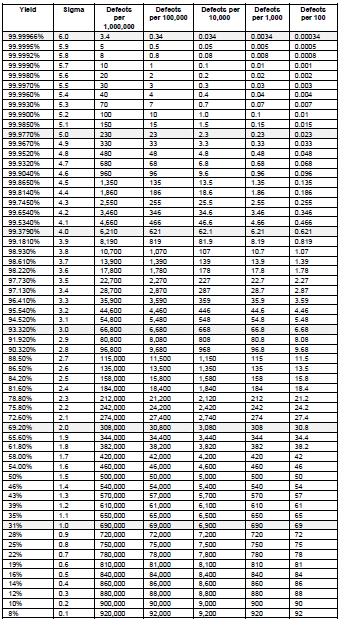Tags
Tags
Tags
Tags
If you are new to Lean Six Sigma then Y=f(X) is one amongst many jargons that you will have to familiarize yourself.
The objective of Lean Six Sigma philosophy and DMAIC improvement methodology is to identify the root causes to any problem and control/manage them so that the problem can be alleviated.
Six Sigma is process oriented approach which considers every task as a process. Even the simplest of the tasks, such as performing your morning workout or getting ready to office is considered as a process. The implication of such a view point is to identify what is the output of that process, its desired level of performance and what inputs are needed to produce the desired results.
Y is usually used to denote the Output and X for the inputs.
Y is also known as dependent variable as it is dependent on the Xs. Usually Y represents the symptoms or the effect of any problem.
On the other hand, X is known as independent variable as it is not dependent on Y or any other X. Usually Xs represents the problem itself or the cause.
As you will agree that any process will have at least one output but most likely to have several inputs. As managers, we all are expected to deliver results and achieve a new level of performance of the process such as Service Levels, Production Levels, Quality Levels, etc., or sustain the current level of performance.
In order to achieve this objective, we focus our efforts on the output performance measure. However a smart process manager will focus on identifying Xs that impact the output performance measure in order to achieve the desired level of performance.
How does one identify the input performance measures or Xs?
Six Sigma DMAIC methodology aims to identify the inputs(Xs) that have significant impact on output (Y). After that the strength and nature of the relationship between Y and Xs are also established.
Six Sigma uses a variety of qualitative and quantitative tools & techniques listed below to identify the statistical validation of the inputs (or root causes), their strength and nature of relationship with Y:
- Cause and Effect Diagram/Fish Bone diagram
- 5 Why Analysis
- Process Maps
- Histogram
- Descriptive Statistics
- Run Charts
- Normal Distribution Plots
- Box plots
- Stem and Leaf Plots
- Hypothesis Testing
- ANOVA (Analysis of Variance)
- Chi-Square Test
- 1-t Test
- 2-t Test
- Paired t Test
- Correlation
- Regression
- Scatter Plots
- Statistical Process Control (SPC)/Control Charts
What does f in Y= f(X) mean?
‘f’ represents the nature and strength of the relationship that exists between Y and X. On one hand, this equation can be used for a generic interpretation that symbolizes the fact that Y is impacted by X and nature of relationship can be quantified. On the other hand, such a mathematical expression can be created provided we have sufficient data using the above mentioned analytical tools such as regression and other hypothesis tests.
The mathematical expression that we obtain is nothing but an equation such as:
TAT = 13.3 – 7.4*Waiting Time + 1.8*No. of Counters – 24*Time to Approve
Once such an equation is established, it can be easily used to proactively identify the Y for various values of X. Thus Y= f(X) is the basis for predictive modeling. All the newer analytical concepts such as Big Data, etc are based on this foundation principles.
Tags
Tags
Tags
Tags
Tags

Tags
Lean Six Sigma Project – A beginner’s guide is a series that explains how to run Lean Six Sigma projects in detail. The biggest benefit of combining Lean and Six Sigma is to deliver more value to customers and business. In order for a Six Sigma Green Belt to be successful with a project, they must know what’s to be done, and how to accomplish them! This guide is a step-by-step procedure to execute the 5 phases of a Lean Six Sigma project.
Lean Six Sigma improvement projects follow 5 phase DMAIC approach. A six sigma project is not an academic exercise, but its primary objective is to impact customers, business, and employees positively. Thus stakeholder buy-in and sponsorship are very important factors for its success. Every project should have at least one project sponsor (One sponsor is just fine, two is OK, but greater than that is undesirable). The project sponsor is usually the process owner or a senior management executive who is accountable for the overall project and its success. They take the lead in identifying the project & its objectives, and in team formation.
The team composition should be cross-functional. The sponsor also has to decide whether this Six Sigma project should be led by a Black Belt or Green Belt. Once identified, the respective Six Sigma Belt plays the lead role in the project. It is their responsibility to complete the project on time, and deliver desired results. Now, for the remaining part of this beginner’s guide, let’s assume that it is a Lean Six Sigma Green Belt Project.

The duration of a typical project should be between 3 to 4 months. The overall project plan for all Six Sigma improvement projects are mapped to Define, Measure, Analyze, Improve, and Control. There are defined deliverables for each of these phases which have to be accomplished before progressing further. At the end of each phase, a formal tollgate is used to stage a gate review by the sponsors. Various Six Sigma concepts and tools can be applied to progress and accomplish desired phase-wise outcomes.
In order to make sure the project meets the timeline, and set-out objectives; the Green belt and team members are to meet regularly. In addition to this, Six Sigma Green Belts are mentored by Black Belts or Master Black Belts.
In a nutshell, following are the broad outlines for each of the DMAIC phases of Lean Six Sigma Project:
- Define – Identify the project objective and define the problem to be solved
- Measure – Collect necessary data regarding the problem and establish current performance
- Analyze – Use the data collected to analyze and screen factors which are the root causes for a problem
- Improve – Identify suitable solutions to overcome the root causes
- Control – Implement the solutions and monitor its results
Next, as a part of this beginner’s guide, let’s understand how to accomplish the deliverable of the Define phase here. Next >>>
Tags
Design for Six Sigma (DFSS) is an approach that is part of the Six Sigma methodology, and it aims to develop products and services which operate at Six Sigma or above. What does this mean; and how is this approach different from implementing six sigma in existing products, services & processes? If you have read our articles What is Six in Six Sigma, and What is Sigma in Six Sigma; you will understand how Six Sigma is measured.
Every process performs at its designed and operating capability. For instance, consider the Indian traffic and transportation management system. A good measure of its performance is the number of deaths due to road accidents. There are several other measures, but for simplicity let’s just consider this one. This performance measure is called CTQ (Critical To Quality).
India has the largest number of deaths per year due to road accidents (Approximately 130,000 deaths per annum). If we were to commence a Six Sigma project to reduce the number of deaths, we would use DMAIC approach. We will identify root causes for this problem, and try to eliminate them with good and sustainable solutions. For instance, helmets and seat belts mandatory, enforcement of speed limits & drunken driving laws, additional traffic patrols, etc., may be few solutions we will implement.
By doing so, lets hypothetically assume that we have been able to reduce the number of deaths to 30,000 per annum, in 3 years’ time. However, we aren’t able to reduce it any further. This stage; when any process or system is delivering its best performance, is referred to as Process Entitlement.
However, 30,000 is still a high number and we want to bring it down to manageable double digits. So we have to discard our existing traffic & transport management system; and design a completely new system, from scratch, that will help us reach our target. Double digit fatality means we will operate well within Six Sigma level, considering our 1.2 billion population as a base.
Such a process of re-designing or newly designing any product, service or products is referred to as DFSS. Design for Six Sigma is defined as a Customer focused design approach used for creating products, services, and processes which will deliver Six Sigma Performance. Samsung products are a very good example of Design for Six Sigma.
In many fields like airline, surgery, automobile braking, etc., require processes to deliver Six Sigma at all times. For such systems, design for six sigma concept comes handy. The very first time products and processes are developed, they are designed to deliver Six Sigma performance.
Following are the key differentiators for DFSS:
- Understand customer requirements, and translate them to product performance measures.
- Design products, sub-systems, and processes to deliver Six Sigma performance.
- Design ‘first time right’ products and services.
- Innovative designs deliver Six Sigma performance, rather than existing designs.
- Optimize the design for usability, manufacturability, or serviceability.
While DFSS is a principle, there are different ways in which it can be put to use. IDOV and DMADV are popular approaches.
IDOV is a 4 step approach representing Identify, Design, Optimize & Verify. And DMADV is a 5 step approach representing Define, Measure, Analyze, Design & Verify.
Tags
While the deployment of Six Sigma depends on several factors; the following approach explains Six Sigma process in its simplest form.
Six Sigma as a management discipline puts customer’s interest ahead of others. The process of gathering customer requirements is called as Voice of Customer (VOC). A good deployment program starts with VOC. Customer requirements directly translate into business performance standards. In Six Sigma and many quality management approaches, these performance standards are called as Customer Specification Limits.
Operational metrics and performance measures like KPIs are created based on customer requirements. Such operational measures or KPIs are called as Critical To Quality (CTQ) metrics in Six Sigma.
Output of existing processes is measured against customer requirements. This becomes a benchmark of performance. In Six Sigma, this step is called as Assessment of Current Process Capability.
In case an end-to-end process is not capable of consistently meeting customer requirements, and produces high volume of defects; it is taken up for improvement.
Process improvement approach used in Six Sigma is called as DMAIC. It is the acronym of Define, Measure, Analyze, Improve and Control: a 5 step improvement approach.
In this manner, Six Sigma aims to link Customers, Business Processes, CTQs and process improvement all together.
The real power of a Six Sigma Process is in consistently and iteratively following the above activities.
Thus, an organization following a Six Sigma Process:
- Systematically and regularly gathers VOC
- Measures its process capability
- Identifies improvement opportunities
- Uses DMAIC to improve its processes
Tags
Six Sigma & Project Management are two high trending topics of interest among professionals and organizations today. While Six Sigma is a management approach, project management principles instill the rigor of execution.
Whatever is the nature of your business, innovation is critical today. In order to survive competition and be the customers’ choice, you need to come up with really new products and services.
All it means is that your change management ability is a direct measure of your success. In other words, timely launch of new products/services in desired quality and price are going to determine your success; apart from the cultural change aspect. So whether you want it or not, good project management skills are essential in today’s business to survive and win. Without digressing on other pre-requisites of good project management, let’s focus on one of most important but rarely focused area.
There are several project management techniques and tools available, such as: CPM, PERT, and Critical Chain. Immaterial of the base on which these models are structured, out of my experience, everything finally boils down to predicting the time duration for a task and delivery as predicted.
In small organizations (less than 10 employees), it is more of coordination, multi-tasking, and communication that will determine if a task can be completed as predicted. But with organizations involving a few hundreds of employees, it is all about how resources and efforts are synchronized. There may be lack of knowledge of what is to be done next, on who owns which piece, how & when to escalate, and lack of clarity on authority & decision making. Additionally, unlike big organizations, smaller companies will have to manage with inexperienced and understaffed scenarios.
So to make life easy for everyone; if processes associated with project management such as supply chain management processes, finance processes, clearly defined inter-department service levels and authorities, etc., are established well; it will help the organization deliver projects in time. Isn’t this what ‘Process Orientation’ is all about!
Strong Process Orientation: one of the key foundations of Six Sigma is responsible for success in most project based industries. Mathematically also it makes sense to focus on process orientation. For instance, consider the PERT model in which the PERT Time (Task duration) is a function of Optimistic Time (OT), Most Likely Time (MLT), and Pessimistic Time (PT). When OT and PT are wide apart, it means that it is not possible to predict the task duration accurately. In other words, the process on which the task is dependent has high variation. Such a process leads to higher PERT Time. When all the tasks of a project have widely spread OTs and PTs, the overall project duration itself will be high and unpredictable.






